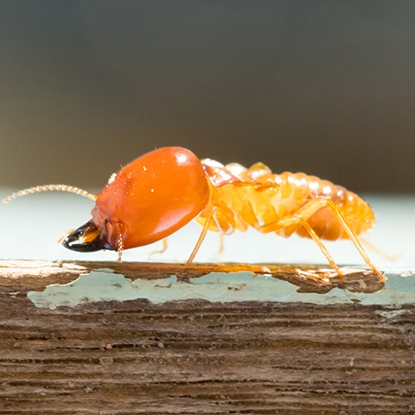
Termites

About
What are termites?
Termites are social insects that live together in large colonies. Termites feed on items made of cellulose and can become quite destructive when they decide to feed on structural wood found in homes and other buildings. The most common species found living and feeding in Texas and Arkansas is the Eastern subterranean termite.
The social structure of a termite colony is quite complex. Members of the termite colony are divided into different groups or castes; working together to maintain the colony. Termites divide themselves into workers, soldiers, and reproductives (kings and queens).
Workers
Worker termites make up most of the colony, gathering food for the entire colony. Workers have soft, creamy-white bodies, are blind, and wingless.
Soldiers
Soldier termites have the responsibility of guarding the termite colony from dangers. They are larger in size than the workers, have elongated yellow head, very short legs, and very large and powerful jaws.
Reproductives (AKA Swarmers)
The reproductive members of the colony are the largest members, are dark-brown to black in color, and are winged.
Are termites dangerous?
Termites pose a danger to wooded structures, but are not a direct danger to people. Termites do not bite people, aren’t known to transmit any disease, and rarely even come into contact with people.
One of the reasons why termites are such a danger is because their presence is so hard to detect. Termites can be described as “cryptic”, they tunnel through the inside of wood, leaving the exterior almost completely intact and “normal” appearing. Termites can be inside of home tunneling through and weakening is structural wood for months or years before their presence is discovered.
Why do I have a termite problem?
Eastern subterranean termites live and feed in the soil. They are attracted to properties that have damp decaying wood. Termites feed on things like fallen trees, tree stumps, old roots, and fallen branches. If termites are nesting and feeding on your property there is a good chance they will eventually make their way into your home.
While out foraging for food termites can easily enter into homes through cracks in the foundation. Termites also find their way inside of a home through soil that comes in contact with doorframes, deck posts, wood shingles and porch steps/supports.
In addition, a termite swarm is another way termites can be introduced onto a property. If there is a mature termite colony nearby when termites swarm from it to mate they may end up on your property and eventually inside of your home.
Where will I find termites?
Outside termites create their nest in the ground underneath of moist soil. Termites travel from their food source to their nest through underground tunnels or mud tubs they create on the surface of basement walls, foundations, and the ground.
Inside of homes and other structures they travel behind walls and underneath flooring, tunneling through and feeding on things like structural supports and beams, flooring, wooden trim, and sub-flooring- preferring water damaged or decaying wood.
How do I get rid of termites?
The only way to completely get rid of termites is with the assistance of a trained professional. At Pest-Pro Services, Inc. the first step we take to get rid of termites is to provide a free inspection and estimate. Our dedicated technicians then provide the services needed to completely eliminate destructive termites from your home and property.
Pest-Pro Services, Inc. is committed to using advanced products to get rid termites and prevent their return through our guaranteed termite control services. To learn more about eliminating termites from your Gilmer, Longview, or Texarkana area home, contact Pest-Pro Services, Inc. today.
How can I prevent termite infestations?
In combination with professional pest control services from Pest-Pro Services, Inc., there are things that you can do around your Texas home and property to make it less attractive to wood-eating termites:
- Clean gutters regularly to prevent water from backing up and seeping into your home’s walls.
- Place weather stripping around windows and doors to prevent water from seeping inside.
- Repair leaky pipes, faucets, or fixtures located inside or outside your home.
- Remove water-damaged wood from your home.
- Limit soil-to-wood contact near or in your home.
- Use dehumidifiers to reduce humidity levels in your home.
- Remove fallen trees, tree stumps, and other piles of organic debris from your property.
- Leave a stone barrier between any soil or mulch and your home’s foundation.